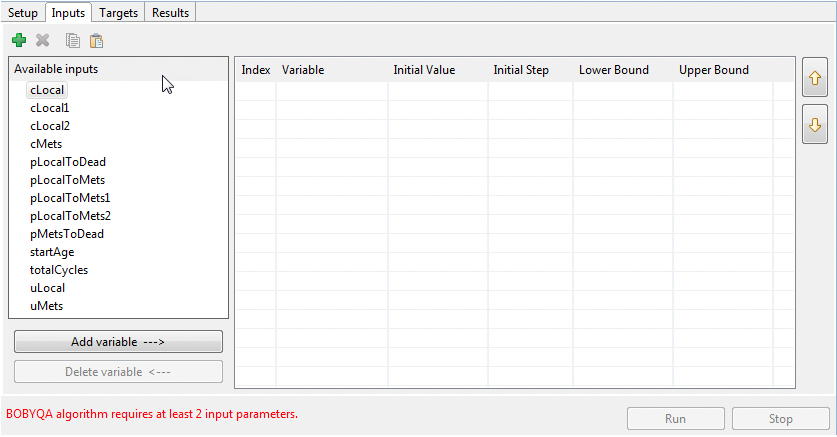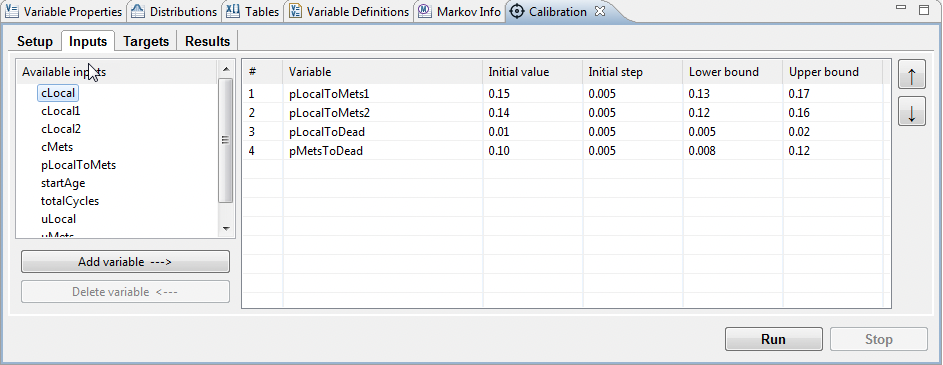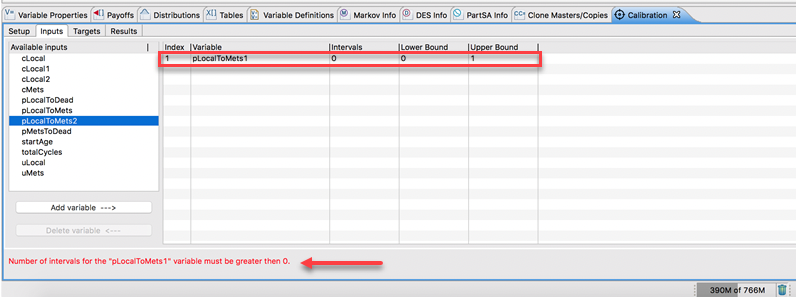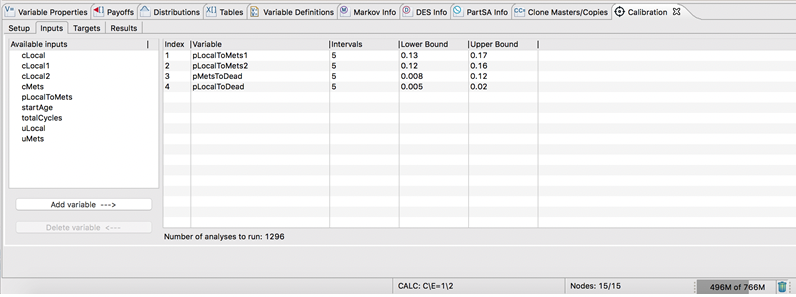54.5 Calibration Inputs
The Calibration View - Inputs Tab is used to select the input parameters that can be modified by the calibration process. The following figure shows the Inputs Tab prior to selection of any specific inputs.

The tab has the following sections:
-
Available inputs: This lists all model input parameters. Choose the inputs you want to include from this list via the "Add variable" button. Use the "Delete variable" button to remove a selected input.
-
Selected input list: This lists the variables which have been selected to be adjusted in the calibration. After selecting a variable, you will need to add details about how they can be changed as part of the calibration process.
-
Tool bar which consists of:
-
Add: Green + will add the variable highlighted in the list "Available inputs" into the table (same as the Add Variable button).
-
Delete: Red x will remove the variable highlighted in the table (same as Delete Variable button).
-
Copy: Use this to copy the Variable name and values from the 4 columns. You can then paste the values into another model (using the past button) or into another document, such as Excel.
-
Paste: Use this to paste Variable names and values for the 4 additional columns into the Inputs Table. Be careful to include all rows/columns when copying data back to TreeAge Pro.
-
In our Example models, the selected inputs are transition probabilities which will directly impact the 5-year survival values. You would select inputs appropriate for your calibration.
The rest of this section is split into two sections, the first for parameter inputs for the BOBYQA and Nelder-Mead algorithms and the second for parameter inputs By Deterministic Parameter Ranges.
54.5.1 To add parameters to Calibration Inputs (for BOBYQA and Nelder-Mead):
-
Use the Example model: Calibration-Markov.trex
-
Select the parameter from the Available inputs box and use the "Add variable --->" button below to add it to the list on the right handside. Once selected, you must then enter additional information for each input.

-
Initial value: This is the input value used for the first calculation in the calibration process. It is initially populated with the current value from the model.
-
Initial step: This is the size of the first value change as the inputs are modified by the calculation process. In the example model we have used 0.005.
-
Lower bound: This is lower limit for the input. The calibration will not change the input value below the lower bound. In this model it will be set to the lowest value of the parameter for pLocalToMets1 which is 0.13.
-
Upper bound: This is upper limit for the input. The calibration will not change the input value above the upper bound. In this model it will be set to the highest value of the parameter for pLocalToMets1 which is 0.17.
Please note: Set reasonable lower and upper bounds for your parameters. You don't want the calibration process trying unreasonable values.
If you enter invalid data (no step, upper bound < lower bound) errors will be reported below the inputs list. See figure above where an error is highlighted by the red arrow.
Healthcare Example Model, Calibration-Markov.trex already has inputs selected and steps/limits defined as show in the figure below.

54.5.2 To add parameters to Calibration Inputs (for By Deterministic Parameter Ranges):
-
Use the Example model: Calibration-Markov-Deterministic.trex
-
Select the parameter from the Available inputs box and use the "Add variable --->" button below to add it to the list on the right handside. Once selected, you must then enter additional information for each input.

-
Intervals: This is the number of calculations between the lower and upper bound the algorithm will perform. The more intervals and variables, will result in a larger number of recalculations.
-
Lower bound: This is lower limit for the input. The calibration will not change the input value below the lower bound. In this model it will be set to the lowest value of the parameter for pLocalToMets1 which is 0.13.
-
Upper bound: This is upper limit for the input. The calibration will not change the input value above the upper bound. In this model it will be set to the highest value of the parameter for pLocalToMets1 which is 0.17.
Please note: Set reasonable lower and upper bounds for your parameters. You don't want the calibration process trying unreasonable values.
If you enter invalid data (non-integer or zero interval, upper bound < lower bound) errors will be reported below the inputs list. See figure above where an error is highlighted by the red arrow.
The number of variables and the number of intervals for each variable will determine the number of analyses to run, which you can see at the botton of the Calibration View for Inputs.
Healthcare Example Model, Calibration-Markov-Deterministic.trex already has inputs selected and intervals defined as show in the figure below.

